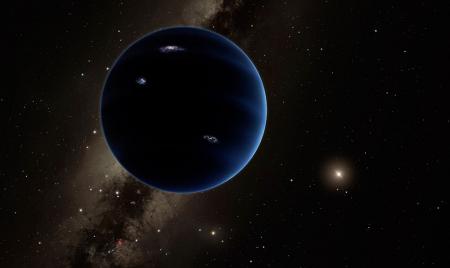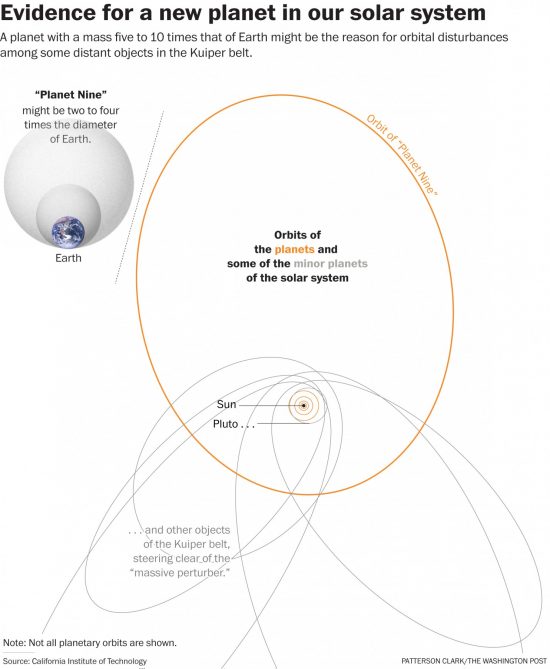October 25, 2016 – A reader of this blog recently sent me an online posting about Planet Nine, formerly called, Planet X and stated that he couldn’t wait for me to write about it. Well here goes.
When I grew up there were nine planets in the Solar System and then scientists in the 1990s got cute and decided to demote Pluto to a dwarf planet. That’s because they discovered many other objects in the Kuiper Belt, a region of the Solar System in which Pluto inhabits. Then New Horizons rendezvoused with Pluto and had astronomers thinking about maybe reversing the demotion decision because Pluto ended up being far more complex and planet-like than anyone previously thought.
Planet X theorists have been around for some time. A hypothetical planet well beyond Pluto has been speculated upon for many years. Its existence would explain odd behaviours in the outer Solar System. For example why some Kuiper Belt objects clustered together and followed odd orbital paths around the Sun. Back in January of this year astronomers at Caltech said they had found evidence of Planet X and it was at that time that they give it the new name, Planet Nine. They published their findings in The Astronomical Journal in an article entitled, “Evidence for a Distant Giant Planet in the Solar System.”
In the analysis the astronomers wrote that distant Kuiper Belt objects not only cluster in orbit perihelion but also in physical space. (Perihelion is the point of orbit when an object is closest to our Sun. Physical space relates to the tight confinement of the noted Kuiper Belt objects being impacted by the suspect Planet Nine.) One of those objects is Sedna, defined today as a dwarf planet. It is much smaller than Pluto. In fact it is smaller than Charon, Pluto’s largest moon. But its orbit is far more eccentric than Pluto’s. And it is that orbit the authors argue as well as the orbit and position of other Kuiper Belt objects that has “only a probability of 0.007% to be due to chance, thus requiring a dynamical origin.” Hence the existence of a hypothetical large planetary body.
Why Planet Nine, estimated to be a super-Earth in size, similar to the mass of Uranus and Neptune, would exist in the outer reaches of the Solar System is explained by the theoretical reconstruction of the early history of our planetary system. In that construct astronomers blame Jupiter with Saturn playing a supporting role. It is believed that these two gas giants caused Planet Nine to get flung out to where it resides today.
Astronomers have called Jupiter the planetary bully because of its significant mass and powerful gravitational pull. And during the Solar System’s formation it is hypothesized that the giant planet began much closer to the Sun than its present orbit. Influenced by proximity of a second giant, Saturn, the two asserted enough gravitational influence upon each other to spiral outward to their current positions as the fifth and sixth planets.
The theoretical Planet Nine encounter with Jupiter was not as benign as that of the mutual attraction asserted with Saturn. Planet Nine got pushed by angular momentum and torque to spiral outward and assume an orbit well above the orbital plane of the other planets. The fact that it survived its close encounter with Jupiter may be explained by the angle of its approach and the distance it traveled away from the gas giant. That cannot be said for other early members of our young Solar System who may have had multiple close encounters with Jupiter ripping them apart. The evidence of those encounters can be found in both the Asteroid and Kuiper Belt today.
So where is Planet Nine? Probably 20 times further away than Neptune, the current Planet Eight, and well above the common planetary plane of our Solar System. But Planet Nine is not the only explanation given for the behaviour of Kuiper Belt objects. Another theory posits the existence of a dim Red Dwarf star whose path every 27 million years comes close enough to the Solar System to act as a disruptor of Kuiper Belt and Oort Cloud objects. Called Nemesis, or the Death Star, it has yet to be found.
Planet Nine’s existence has become the current hot theory further hyped by the latest observations describing a wobble in the Solar System that tilts it in relation to the equatorial and axial orientation of the Sun. The explanation given is that when Planet Nine got tossed by Jupiter its path around the Sun was significantly altered placing it at least 30 degrees above and below the common orbital plane of the other eight planets. The planet’s mass (speculated at anywhere from 4 to 10 times Earth), although not as large as Jupiter (it would be the fifth largest planetary object), and its far-flung orbit could be an explanation for the current 6 degree tilt of the common planetary plane. Why is that?
For an explanation you have to go back to our understanding of how the Solar System got started. When the proto-solar nebula formed the Sun the remaining gas formed a rotating disk sharing common angular momentum. The planets formed out of this gas aggregating matter over time. Their orbital inclination continued to be the same. But today we don’t see this. Instead all of the eight planets orbiting the Sun are at a 6 degree tilt when compared to our star’s axis and equatorial plane.
The theory posited is that of a distant object in the outer reaches of the Solar System exerting angular momentum providing torque leading to a twisting force that over many billions of years has grown to the current 6 degree tilt. The distance of that object from the Sun and its exaggerated orbit (a significant difference between perihelion and aphelion) helps exert even greater angular momentum than if it were closer to the centre of the Solar System and had a more circular orbital path. Over billions of years of orbits, each speculated to last more than 20,000 Earth years, that object has produced the end result we see today, a Sun with an axis of rotation offset from the planetary plane by 6 degrees making our star appear to us as if it were tilted.
That object, the elusive Planet Nine, remains theoretical. All that’s left is to find the damn thing and turn it into fact to confirm these theories. But that’s not going to be easy because there is a lot of space above and below the common orbital plane of our Solar System. And Planet Nine (see artist rendition below) is an object so distant it would only dimly reflect light from the far away Sun. Nonetheless astronomers will continue to look and theorize about the quirks that characterize our Solar System today.
Artistic rendering of Planet Nine with the Sun in the distance. Image credit: R. Hurt, IPAC, Caltech.










